How to Grow Radishes for Beginners
This article will walk you through How to Grow Radishes for Beginners. From planting to watering, what to watch for and how to harvest.
By the end, you will feel confident enough to add this fun crisp veggie to your backyard garden and your gardening 101 library.
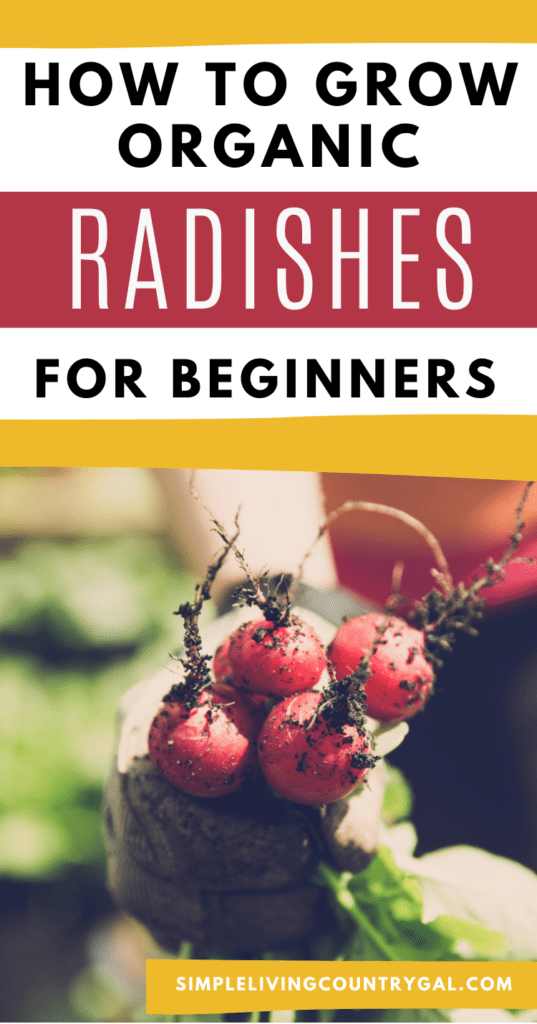
Radishes are one of the easiest vegetables to grow, making them perfect for beginner gardeners. They mature quickly and you can plant them in both early spring and early fall, ensuring a steady crop for months on end.
Radishes are also a good source of vitamin C, make a great addition to salads or a quick afternoon snack. In the garden, they make excellent companion plants allowing you to tuck them into spaces throughout. Best of all, every part of the radish is edible so there’s no waste.
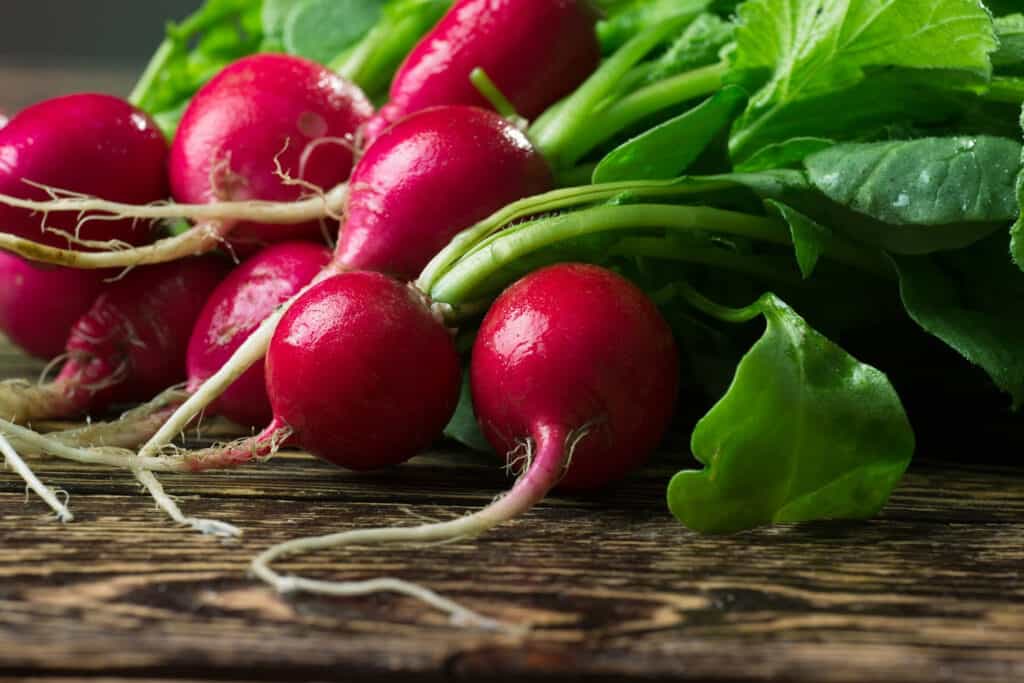
You’re probably used to eating radishes raw as part of a salad or on a tea sandwich, but they can also be roasted, steamed, or sautéed and added to a variety of dishes. The greens are also quite tasty in a salad and the seed pods are a great addition to soups and stir-fries.
Growing Radishes the Basics
Radishes are part of the mustard family and are closely related to arugula, broccoli, cabbage, cauliflower, kale, and turnips.
Colors and sizes vary based on the type, but they basically fall into three main varieties:
Early – These grow in cooler months, early spring and fall, and mature in about 20-30 days.
Midseason – These summer varieties are more heat resistant and can be planted from May to August. They’re on the smaller side and take a little longer to mature, about 30-40 days.
Late – These are also known as winter radishes and can be planted throughout the winter in warmer climates. These tend to have larger roots and need even longer to grow, about 60-70 days.
A few radish varieties to choose from include:
· Watermelon – mild and sweet with white skin and a pinkish center
· French Breakfast – late-maturing variety, does fine in moderate heat
· Burpee White – a spring variety with white skin
· Daikon – white winter radish from Japan, can grow up to 16 inches long. It’s best in cooler temperatures.
· Rat’s Tail and Dragon’s Tail – grown for their seed pods instead of their roots. The pods are tangy and spicy with a stronger flavor than the root.
What You Need to Grow Radishes
Radishes need plenty of sunlight. If you plant them in shady areas or even in an area where they are shaded by other plants, all of their energy will be put into growing bigger leaves instead of bigger vegetables.
You’ll also need loose soil to grow radishes. Like carrots, they are a root vegetable and will need good drainage and looser soil. If your soil is more clay-like, add some sand to loosen it up. Your soil also needs to be free of rocks and dirt clods.
It’s best to plan to rotate your crop each year, planting in a new spot and not reusing a spot for at least three years. This will help to prevent diseases from the soil that can quickly infect your crop.
How to Grow Radishes
Radishes are fairly easy to grow, but you’ll want to plant the seeds directly in the ground instead of starting your seedlings indoors. This will keep the roots from being disturbed.
For a continuous harvest, plant a new round of seeds every 10-14 days while the weather is still cool. This will allow you to harvest from spring to early summer. You can do the same in early fall and continue harvesting through October if you live in a warmer climate.
When to Plant Radishes
For a spring planting, sow seeds about 4-6 weeks before the last frost. For fall planting, you can plant later than other root vegetables since they do not take as long to mature.
Sew seeds every few weeks to produce a continuous harvest.
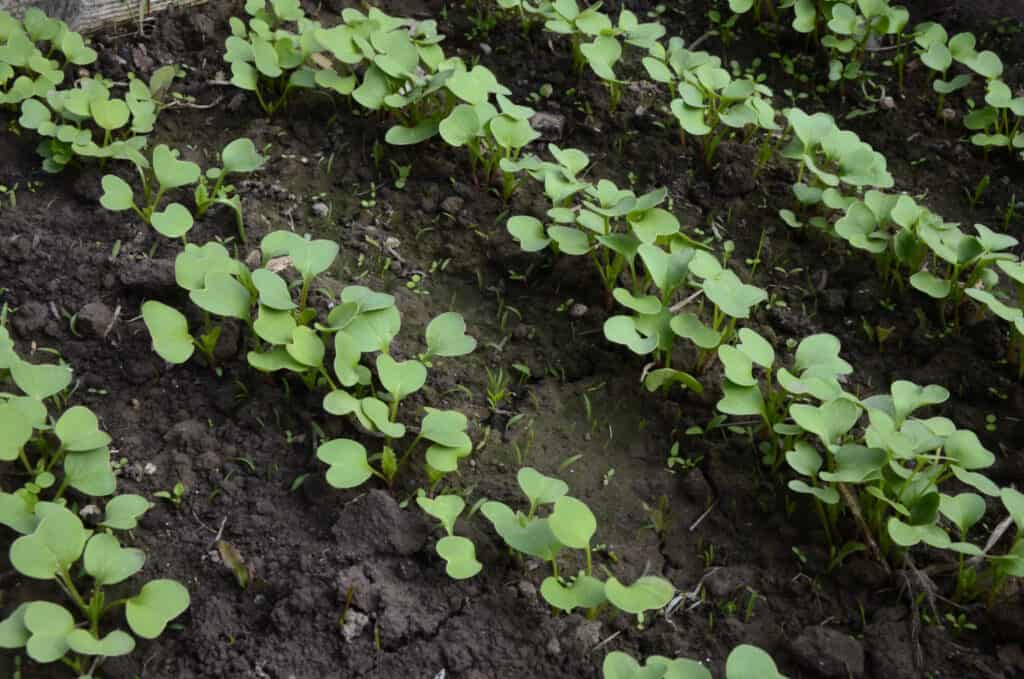
How to Plant Radishes
As mentioned above you will need loose soil with good drainage. If you have rocky soil or dirt clods, you’ll want to break those clumps up and remove as many rocks as possible before planting. If your soil is clay-like, mix in some sand to help create a looser soil that will properly drain water away. While you do want your radishes to get plenty of water, you also want it to drain well or it will cause rot and ruin your crop.
How Many Plants to Plant
For a decent size crop that you can enjoy in several dishes, plan on planting 10-15 plants per person in your household.
How Long Do Radishes Take to Grow?
Radishes can take anywhere from 20 to 40 days to mature depending on the variety you plant and the temperature of the soil when you plant. In early spring, you can expect to harvest within 3 weeks. A fall planting will take a bit longer to mature.
Temperature
Radishes grow best in warmer climates, from early spring to early fall. You’ll want to wait until the ground is workable to start planting. Since radishes grow so quickly, you can plant one last time in the early fall and harvest before the first frost. You can grow radishes in temperatures from 40° to 70° degrees, but optimal temperatures are 60° – 65°.
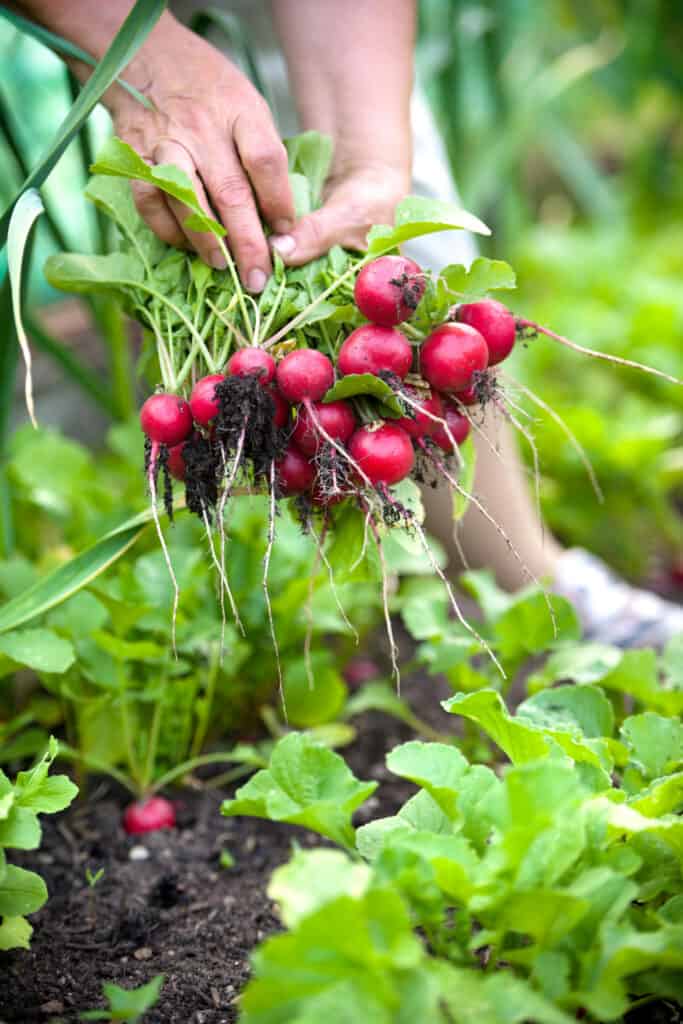
Sun
Radish plants are going to need at least 6 hours of sunlight a day. If they are in a shady spot or they are shaded by a larger plant, they won’t mature properly; all the nutrients will be directed to the leaves and not the vegetable.
Soil
The perfect soil for radishes is loose soil with good drainage. Prepare your planting spot before sowing the seeds by loosening the soil, removing rocks and soil clods. If the ground soil is too hard, add some sand to loosen it up. Make sure that water drains away and doesn’t puddle, this can cause the plants to rot.
After planting, cover the soil with a layer of mulch enriched with wood ashes. This will deter root maggots and help the soil retain moisture.
It’s best to plant radishes in different areas of your garden, rotating the planting sites and not coming back to one for about 3 years. This will help to reduce the chance of disease that can live in the soil.
Water
Radishes need to receive a significant amount of water, but you also don’t want to water too heavily at once; the soil won’t be able to absorb it all and it can cause the water to pool around the plants. Since radishes grow in the summer when there tends to be less rain, you should plan on watering them 2-3 times a week, soaking the soil until it’s moist.
Fertilizing
You’ll want to avoid over fertilizing when planting radishes. An overly rich soil will encourage foliage growth instead of root growth. When planting, avoid using fresh manure, organic materials, or fertilizers high in nitrogen. Work a small amount of fertilizer into the soil before sowing the seeds. Use an all-purpose fertilizer, such as a 10-10-10, and mix about 1 cup for every 10 feet of planting area. Thoroughly work the fertilizer into the top 6 inches of soil.
Spacing
When planting, sow several seeds together as some will not germinate. Once the seedlings are about 2 inches tall, thin the plants to 3-inches in spacing to give them plenty of room to grow. Pull the seedlings from the soil instead of digging them up so you don’t disturb the roots of the other plants.
If you don’t thin the plants, they’ll become overcrowded, leading to shriveled up, inedible vegetables.
Depth
When planting, sow radish seeds ½ to 1 inch deep and about 1 inch apart in rows that are 12 inches apart. Remember to thin them out to 2 to 3 inches apart once the seedlings sprout.

Growing Tips for Radishes
- Water your radishes in moderation. If the soil becomes too wet, the roots will split and rot. If the soil becomes too dry, the radishes will become pithy and will be too pungent to eat. Don’t let the soil dry out, but don’t keep it soggy either.
- Radishes are excellent companion plants for peppers, squash, cucumbers, beans, beets, lettuce, mint, parsnips, peas, and tomatoes. They help to draw flea beetles, aphids, and other pests away. Just remember to make sure the radish plants aren’t shaded by any other plants.
- Do a three-year crop rotation, planting in different areas for three years, to help prevent disease.
- For a bountiful harvest, plant seeds every 10 to 14 days while the weather is still cool. This will give you a continuous harvest in late spring and early summer. You can do the same again in early fall and continue to harvest until the first frost.
- For fall planting, sow seeds at least 4 to 6 weeks before the first frost.
- Radish seeds have a long shelf life. You can plant seeds that are up to 5 years old. They may not all germinate, but many will.
How to Harvest Radishes
When growing radishes it is important to know that they mature quickly and will be ready to harvest within weeks of planting. For most varieties, you’ll want to harvest when they are about 1 inch in diameter at the surface of the soil. Pull out one radish plant to test before harvesting the full crop.
Don’t leave the radishes in the ground too long after they mature, they’ll begin to deteriorate quickly and you won’t be able to enjoy them.
Cut off the tops and thin the root tails, wash the radishes and dry them thoroughly. They can be stored in a plastic bag in the refrigerator. Store the greens separately and use them within 3 days.
How to Store Radishes
After harvest, trim the greens and some of the root tails and give your radishes a good wash. Dry them thoroughly to help them last longer. Store them in a plastic bag in the crisper drawer of your refrigerator for up to 2 to 3 weeks.
The greens are tasty in a salad but will need to be washed, dried, and stored in the refrigerator until you use them. The greens are only good for a couple of days so aim to use them quickly.
Radishes are great in a salad, stir-fry, soup, or stew. You can roast them or sauté them; marinate them for Chinese dishes and recipes. They can also be served on their own as a side dish, sautéed in butter and sprinkled with salt, pepper, and herbs.
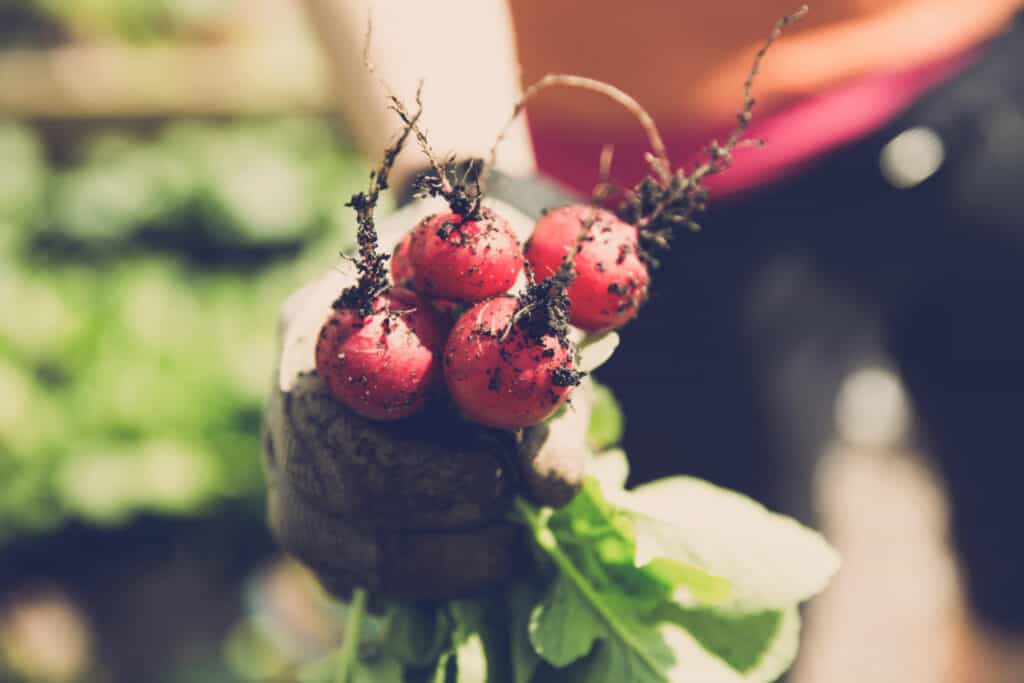
What Diseases and Pests to Watch For
There are a few pests and diseases to keep an eye out for including:
· Root Maggots
· Flea Beetles
· Root Rot
Root maggots can be prevented by rotating your planting area and not planting in the same area twice for at least 3 years. You can help to deter flea beetles with a floating row cover to keep them from attacking the leaves. And root rot can be prevented with good draining soil and by not overwatering.
Fortunately, because radishes mature so quickly, there isn’t much time for many diseases and pests to take over.
Radishes are one of the easiest vegetables to grow so they’re perfect for a beginner gardener. And, since they make great companion plants and help to reduce pests for other vegetables, they also serve as good pest control for your garden. Since they mature so quickly, you can plant over and over again through the planting season and enjoy a great harvest without using up a lot of space in your garden.
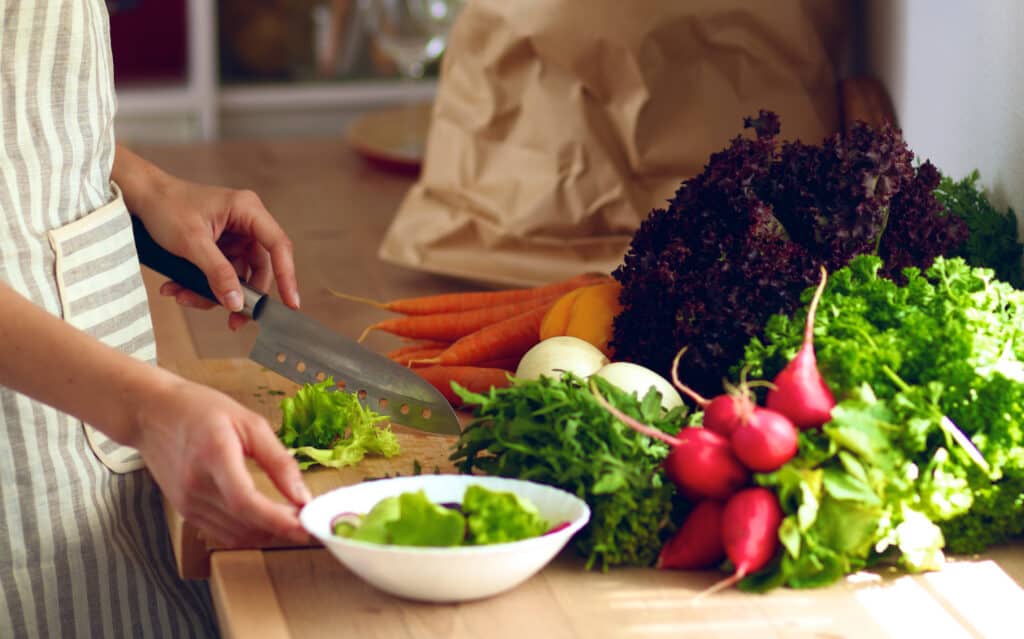
Enjoy!
Many people are only used to eating radishes raw in a salad, but try them in other ways and you’ll be hooked. Sautéing and roasting bring out more flavor, especially if you season or marinate them. You can even shred them into coleslaw, egg salad, or chicken salad.
Radishes are one of the few plants that are completely edible and provide a different flavor with the different parts. Mix the radish greens into your salad mix to bring some extra flavor to a boring salad.
Now that you know how to grow radishes for beginners, you’ll want to grow them over and over and find new ways to add them to your favorite meals.
